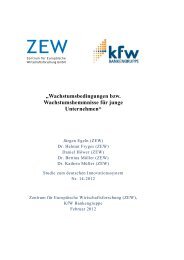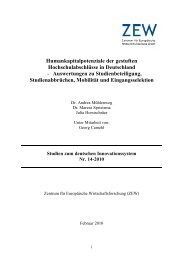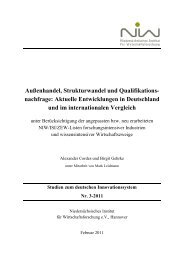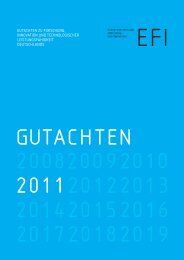research, innovation and technological performance in germany
research, innovation and technological performance in germany
research, innovation and technological performance in germany
Create successful ePaper yourself
Turn your PDF publications into a flip-book with our unique Google optimized e-Paper software.
36<br />
EFI REPORT<br />
2010<br />
ness <strong>and</strong> efficiency of the processes. The analysis<br />
focuses first on non-university <strong>research</strong> <strong>and</strong> its <strong>in</strong>ternal<br />
structures.<br />
The structure of public <strong>research</strong><br />
The total <strong>research</strong> budget <strong>in</strong> the public sector amounts<br />
to EUR 19.8 billion (2008). Of this, EUR 10.7 billion<br />
go to the universities <strong>and</strong> EUR 9.1 billion towards<br />
non-university <strong>research</strong>. At the end of 2008,<br />
the two sectors together were employ<strong>in</strong>g 189 000<br />
R&D personnel (expressed <strong>in</strong> full-time equivalents),<br />
of which 108 000 worked at universities, <strong>and</strong> 81<br />
000 at non-university <strong>in</strong>stitutions. 50<br />
The German science system has fairly unchang<strong>in</strong>g<br />
basic structures, <strong>in</strong> contrast to other <strong>in</strong>dustrialised<br />
countries. This can represent an advantage <strong>in</strong> terms<br />
of the cont<strong>in</strong>uity of <strong>research</strong>, but when it comes to<br />
flexibility <strong>and</strong> <strong><strong>in</strong>novation</strong> dynamics there are also disadvantages.<br />
It is remarkable that the R&D expenditure<br />
of the public science sector as a proportion of<br />
gross domestic product has been stable s<strong>in</strong>ce 1981<br />
at about 0.75 percent. In particular the distribution<br />
between universities (0.4 percent) <strong>and</strong> non-university<br />
<strong>research</strong> (0.35 percent) has rema<strong>in</strong>ed largely constant<br />
over that period.<br />
In the OECD countries, non-university <strong>research</strong> as<br />
a proportion of GDP fell between 1995 <strong>and</strong> 2007<br />
from 0.3 percent to 0.25 percent. 51 At the same time,<br />
the proportion of the <strong>research</strong> <strong>in</strong> the university sector<br />
<strong>in</strong>creased from 0.33 percent to 0.38 percent of<br />
GDP. Other countries also made significant reductions<br />
to non-university <strong>in</strong>stitutional <strong>research</strong> relative<br />
to GDP <strong>in</strong> this period, e.g. <strong>in</strong> the USA from 0.3<br />
percent to 0.25 percent, <strong>in</strong> Great Brita<strong>in</strong> from 0.28<br />
percent to 0.16 percent, <strong>in</strong> France from 0.48 percent<br />
to 0.34 percent, <strong>and</strong> <strong>in</strong> Canada from 0.24 percent<br />
to 0.19 percent.<br />
The expansion of the education system <strong>and</strong> university<br />
<strong>research</strong> has played a key role <strong>in</strong> many OECD<br />
countries s<strong>in</strong>ce 1995 <strong>and</strong> even more so after 2000.<br />
Average expenditure on university <strong>research</strong> as a proportion<br />
of GDP by OECD countries <strong>in</strong>creased from<br />
0.33 percent 1995 to 0.38 percent 2007, e.g. <strong>in</strong> the<br />
USA from 0.31 percent to 0.36 percent, <strong>in</strong> Great<br />
Brita<strong>in</strong> from 0.37 percent to 0.44 percent. The developments<br />
<strong>in</strong> Canada (<strong>in</strong>crease from 0.46 percent to<br />
0.63 percent) <strong>and</strong> Korea (from 0.19 percent to 0.37<br />
percent) are particularly remarkable. Germany has<br />
not matched this expansion of university <strong>research</strong> <strong>in</strong><br />
comb<strong>in</strong>ation with the consolidation of non-university<br />
<strong>research</strong> structures. Significantly, there was a significant<br />
expansion of education over the period <strong>in</strong><br />
question, so that presumable <strong>in</strong>creased teach<strong>in</strong>g obligations<br />
displaced <strong>research</strong> <strong>in</strong> the time budgets of<br />
university staff. Attention should therefore be paid<br />
<strong>in</strong> com<strong>in</strong>g years to a balanced expansion of education<br />
<strong>and</strong> <strong>research</strong>, <strong>and</strong> to improvements <strong>in</strong> the structure<br />
of university <strong>research</strong>.<br />
Sett<strong>in</strong>g priorities <strong>in</strong> the system of non-university<br />
<strong>research</strong><br />
Germany has a highly-developed system of <strong>research</strong><br />
with various <strong>in</strong>dependent science organisations with<br />
very different remits. In 2007, the four most important<br />
organisations employed 56 percent of the scientists<br />
of non-university <strong>research</strong> <strong>in</strong>stitutions, namely<br />
the Helmholtz Association (HGF) 22 percent, Fraunhofer<br />
Society (FhG) 12 percent, the Max Planck Society<br />
(MPG) 11 percent, <strong>and</strong> the Leibniz Association<br />
(WGL) 11 percent. Together they account for<br />
74 percent of the <strong>research</strong> expenditure <strong>in</strong> the nonuniversity<br />
<strong>research</strong> sector. The follow<strong>in</strong>g <strong>in</strong>stitutions<br />
receive about a quarter of the budget for non-university<br />
<strong>research</strong> <strong>and</strong> employ 44 percent of the personnel:<br />
Federal department <strong>research</strong> <strong>in</strong>stitutions 16<br />
percent, Laender <strong>in</strong>stitutions 7 percent, academies,<br />
scientific libraries <strong>and</strong> museums 6 percent, <strong>and</strong> other<br />
<strong>in</strong>stitutions 15 percent. The other <strong>in</strong>stitutions consist<br />
of 400 publicly-funded non-profit organisations<br />
with widely vary<strong>in</strong>g remits <strong>in</strong> science, <strong>research</strong>, <strong>and</strong><br />
technology transfer.<br />
Such organisational <strong>and</strong> <strong>in</strong>stitutional differentiation<br />
can easily lead to <strong>in</strong>efficient duplication <strong>and</strong> <strong>in</strong>adequate<br />
strategic coherence. Over many years, the <strong>in</strong>stitutes<br />
of the Fraunhofer Society (FhG) or the Max<br />
Planck Society (MPG) have developed a clear <strong>research</strong><br />
profile <strong>and</strong> have established an excellent <strong>in</strong>ternational<br />
reputation, but the same cannot be said<br />
for all <strong>in</strong>stitutions. The <strong>in</strong>stitutions organised with<strong>in</strong><br />
Helmholtz Association <strong>and</strong> the Leibniz Association<br />
s<strong>in</strong>ce the 1990s have meanwhile gone through<br />
a transformation process, which has led <strong>in</strong> many<br />
cases to an <strong>in</strong>crease <strong>in</strong> scientific <strong>performance</strong>. Many<br />
<strong>in</strong>stitutes <strong>and</strong> <strong>research</strong> sectors <strong>in</strong> both associations<br />
are of excellent quality.


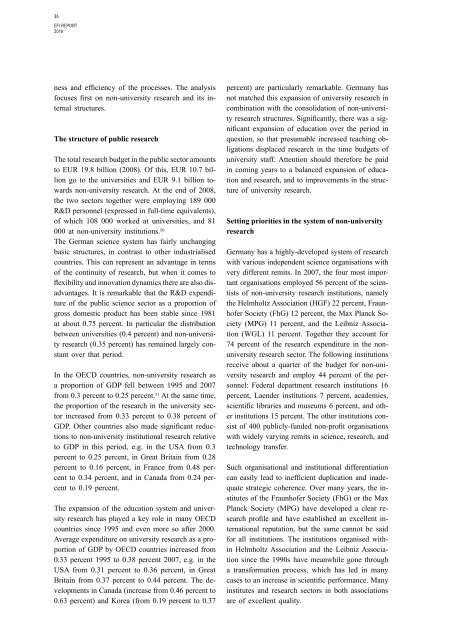
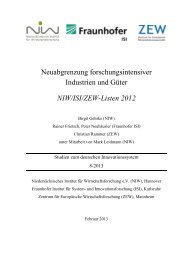
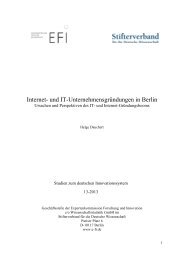

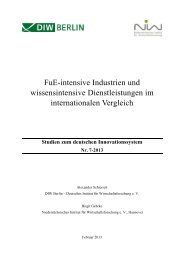
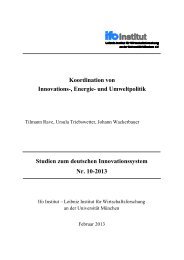
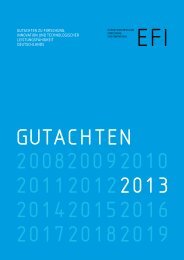
![zur Studie [Pdf, 2.574 KB] - Expertenkommission Forschung und ...](https://img.yumpu.com/20748637/1/184x260/zur-studie-pdf-2574-kb-expertenkommission-forschung-und-.jpg?quality=85)

